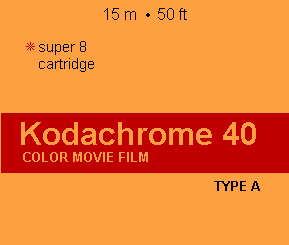

In addition to my many other hobbies, I'm also a Super 8mm filmmaker. Some may ask "Isn't 8mm/Super 8mm dead?" Well, in actuality, it's far from dead. Even though it has been mostly replaced by video and digital, Super 8mm enjoys a cult status among filmmakers trying to achieve a "home movie" look, as well as amateur filmmakers trying to make professional-looking movies "on the cheap" compared to 16mm and 35mm. My main cameras are a Beaulieu 4008 ZM II and a Bell & Howell Autoload 431. My other cameras are a Chinon 132P XL(I don't trust it as much as my 4008 or 431), a GAF Anscomatic (it runs, but I haven't shot a test roll of film with it yet), and a Fujica Z1 (which actually uses Single-8). The Beaulieu and Bell & Howell are solid cameras which are of all-metal (?) construction unlike my Chinon, which is all-plastic. I think the GAF, which was made by Chinon in the late 60's/early 70's, is of mostly metal construction. The Z1 is interesting; it uses Fuji's own "Single-8" format, which was introduced as a competitor to Super 8mm. It uses a different style cartridge, but the film can be used with Super 8mm projectors and editors once processed. So far, I have bought three rolls of Kodachrome 40 color movie film. I bought my film at Walgreens, where they special-ordered it for me (sadly, they aren't able to do that anymore, and K40 is no longer being made). They charged $6.99 per roll, and $8.60 for developing. So far, I have found Super 8mm filmmaking to be fun. Enjoy the site!
5/24/19100 UPDATE: I finally finished my first Super 8mm 'feature' film, "Jar-Jar In Space". To read more about it, click here!
6/12/19100 UPDATE: I got two more Super 8mm cameras at a flea market: a GAF Anscomatic ST87, and a Kodak Ektasound 130.
6/30/19100 UPDATE: More on the Jar-Jar In Space page.
4/17/19101 UPDATE: Man, has it been a while since I updated this page. Anyway, I have recently filmed what may become my next masterpiece (yeah right): Turbinium! I heard that a 500-ton power station turbine was being moved through my hometown, so I grabbed my camera and captured this epic (ahem) event. More later!
3/7/19110 UPDATE: Wow, it has been a very, very long time since I updated this page. As you may have guessed, I haven't done much with Super 8mm in some time. Since I shot my initial 3 rolls, Kodachrome 40 has sadly been discontinued, and Ektachrome 64T is now the only option for color reversal Super8mm film (not sure if any of my cameras would work with it, but who knows). Kodak has also stopped processing Kodachrome film entirely, and Dwayne's Photo will stop processing Kodachrome at the end of 2010. A sad end for a historic filmstock (wonder what Paul Simon thinks...). However, I am considering getting back into Super 8mm, and possibly toying with Single-8, an alternative to Super 8mm which Fuji introduced. I recently picked up a Fujica Z1, which probably needs some work, but if it can be refurbished, I may try shooting some Single-8!
10/11/19118 UPDATE: Wow, another extremely long gap between updates! Unfortunately, my idea for getting into Single-8 never really got anywhere since Fuji no longer manufactures film cartridges (there are other companies making them, fortunately). However, Kodak has recently reintroduced Ektachrome 100D, marking the first availability of Super 8mm color reversal film since Ektachrome 64T was discontinued in late 2009. In personal news, I have lucked into an example of what's considered one of the finest Super 8mm cameras ever, the Beaulieu 4008 ZM II! It likely needs work, not least of which a replacement rechargeable battery pack, but it seems to be in very good shape overall. I'm hoping that these events will facilitate me getting back into filmmaking after nearly two decades of inactivity. As always, stay tuned!
Equipment I Own:
Cameras: Beaulieu 4008 ZM II, Bell & Howell Autoload 431, Chinon 132P XL, GAF Anscomatic ST87, Fujica Z1 (Single 8)
Projector: Kodak Instamatic M50, Sears (model unknown), Chinon 3000GL
Screen: 50"x50" glass-beaded screen of unknown manufacture (Da-Lite?)
Vision3 50D (7203)
Color negative film
ASA 50
Description: I do not know much about these Vision3 filmstocks. Vision3 film is popular with professional filmmakers, but not very useful to most amateur filmmakers. Unlike reversal filmstocks, processed Vision3 50D films cannot be directly projected. Daylight-balanced. Can be used inside with an 80A filter. Due to it's low speed (ASA 12) when so filtered, a movie light is required for indoor filmmaking. Process ECN-2.
Vision3 200T (7213)
Color negative film
ASA 200
Description: Another negative color filmstock. As with Vision3 50D, I do not know much about this filmstock. As with Vision3 50D, and unlike reversal filmstocks, processed Vision2 200T films cannot be directly projected. Tungsten-balanced. Process ECN-2.
Vision3 500T (7219)
Color negative film
ASA 500
Description:Another negative color filmstock. As with Vision3 50D and 200T, I do not know much about this filmstock. Due to it being a negative filmstock, it cannot be directly projected, so it is not suited for amateur filmmaking unless access to professional equipment is available. Extremely-low grain. Tungsten-balanced. Process ECN-2.
Tri-X (7266)
Black & white reversal film
ASA 200
Description: A black and white filmstock suitable for filming indoors or in low-light conditions. Upgrade from the original Tri-X (7278), with better specs. Due to its high speed, care should be taken to avoid overexposing the film when filming in bright sunlight. Process D-94A.
Navigation:
Back to my main page!
My Favorite Super 8mm Web Sites
Kodak's Super8mm film page
Pro8mm - A Source for Film, Cameras, Accessories, etc.
Super 8 wiki
A source for Single-8 film, processing and supplies!
A Guide to Super 8mm Filmmaking
Start Shooting Super 8 Movie Film!
Newsgroup: alt.movies.cinematography.super8